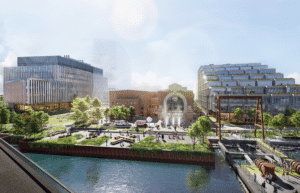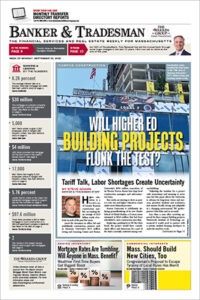
Developers want to start the Boston Edison plant redevelopment with a pair of apartment buildings totaling 636 units, but questions remain about the percentage of affordable units that will be included on the Summer Street property. Image courtesy of Gensler
Location, location and location, the adage goes, are the three keys to a real estate property’s destiny. In Boston, it’s top of mind for developers and city officials seeking to catalyze housing production while satisfying the city’s ambitious requirements to create affordable and market-rate units alike.
Developers are getting an increasingly sympathetic hearing from Boston officials in an effort to break the logjam of housing projects still sitting on the drawing boards.
The Wu administration is in talks with several developers seeking changes to their affordable housing obligations, which could enable them to build only market-rate units on-site, while chipping in for creation of income-restricted units elsewhere.
Mayor Michelle Wu hoped that financial market shifts would help clear a backlog of close to 30,000 permitted but unbuilt units, but additional Federal Reserve interest rate cuts have failed to arrive in 2025 amid lingering inflation fears. So, the city is moving to Plan B.
“This push right now is really recognizing the urgency of getting more shovels in the ground, but also the difficulties when interest rates still have not come down, when we have been hoping that they would,” Wu said in a recent interview. “So, we really need to see how close the projects are to being financially feasible.”
Off-Site or On-Site Units?
The city’s 25-year-old inclusionary development policy seeks to leverage the power of private development to create housing, while requiring a portion of projects to include income-restricted units.
In a low-interest rate environment, the policy enabled luxury developments to subsidize income-restricted units that rent or sell for a deep discount from market rate.
Real estate groups warned last year that proposed increases to projects’ minimum affordable component were coming at the wrong time, following rising interest rates and project budgets that were slowing the pace of groundbreakings.
Until October, the minimum affordable component was 13 percent in projects with 10 or more units, before being raised to 17 percent and an additional 3 percent for federal housing voucher-holders. The policy now applies to all projects with seven or more housing units.
While the administration held firm on implementing the changes in October, it’s been in discussions with several developers seeking relief from on-site affordable commitments made before the markets shifted, Chief of Housing Sheila Dillon said.
“We are looking at those situations one by one by one,” Dillon said. “There hasn’t been a blanket policy change, but we are looking at the economics of every deal to see if some modifications would allow them to get past the finish line.”

City and state officials, including Boston Chief of Housing Sheila Dillon, third from left, pose for a photo at a groundbreaking ceremony for an affordable housing development at 41 Lagrange St. in Boston in September 2024. Dillon and other city leaders say they’re open to developers funding such projects instead of including affordable housing in their new buildings. Photo by James Sanna | Banker & Tradesman Staff
City Hopes to Help Affordable Projects
Under a series of mayoral administrations, Boston officials have encouraged developers to build affordable and market-rate units side-by-side to retain a mix of demographics. The ultra-luxury Raffles Residences Boston in Back Bay included seven income-restricted units, some selling for as low as $175,300.
But the Mayor’s Office of Housing also has the discretion to approve off-site options, involving developers’ financial contributions to outside projects.
The preferred alternative is partnering with an affordable housing developer on a nearby project that needs that last infusion of capital to complete its financing package, Dillon said.
“If a project is many years out and has many other issues, we are less inclined to begin a conversation,” she said.
As a last resort, developers can pay into a city fund that collects off-site contributions, to be designated by the city for specific projects at a later date. The payments range from $200,000 to $380,000 per unit, depending upon the neighborhood.
“The city has signaled that the door is open to conversations,” said Matthew Kiefer, a real estate lawyer at Goulston & Storrs who represents developers in Boston permitting reviews. “They are thinking about them strategically on a one-by-one basis: ‘Tell us what you need, and we’ll consider it.’”
The inclusionary development policy has become a debating point in the Boston mayoral race, with challenger Josh Kraft vowing to roll back the affordable component for stalled projects to 13 percent.
“Most developers think the IDP has been a huge success,” said Joseph Hanley, a partner at Boston law firm McDermott, Quilty, Miller and Hanley. “It’s not really a government program. It’s a development program based upon the ability to create new housing through the private market. The mayor can’t control the macro economy, but when it doesn’t pencil out they just are not going to build it. And that’s what we are seeing.”

Steve Adams
Power Plant Project Seeks Flexibility
The largest approved project to seek changes is the redevelopment of the former Boston Edison property in South Boston, known as 776 Summer. The 15-acre property overlooking the Reserved Channel has sat vacant since a three-year demolition project was completed last year.
The Boston Planning Department is reviewing developers HRP and Redgate’s proposal to begin the 1.7 million-square-foot project with a pair of apartment buildings totaling 636 units. Originally, 100 affordable units would have been built in the first phase.
At an advisory group meeting in February, developers said they are “thinking creatively” about the off-site option, either through contributions to another project in South Boston, a payment to the city or a combination of the two methods. A representative from City Councilor Ed Flynn’s office criticized the idea, and a Boston Planning Department official said the city is reviewing such requests individually. Dillon said the developers have not begun any discussions with her office.
“The city policy always has included those options, but historically it has been rare,” said Mark McGonigle, deputy director of community engagement for the Boston Planning Department. “Given the difficulties in housing, more and more developers are asking.”
In a statement this week, HRP and Redgate said they “remain committed to advancing the 776 Summer project despite the challenging economic conditions. Flexibility to consider a variety of options on the affordable housing component ensures the project will be able to deliver much needed units, including affordable and middle-income housing, to the South Boston neighborhood in addition to the many other public benefits the project has to offer.”






